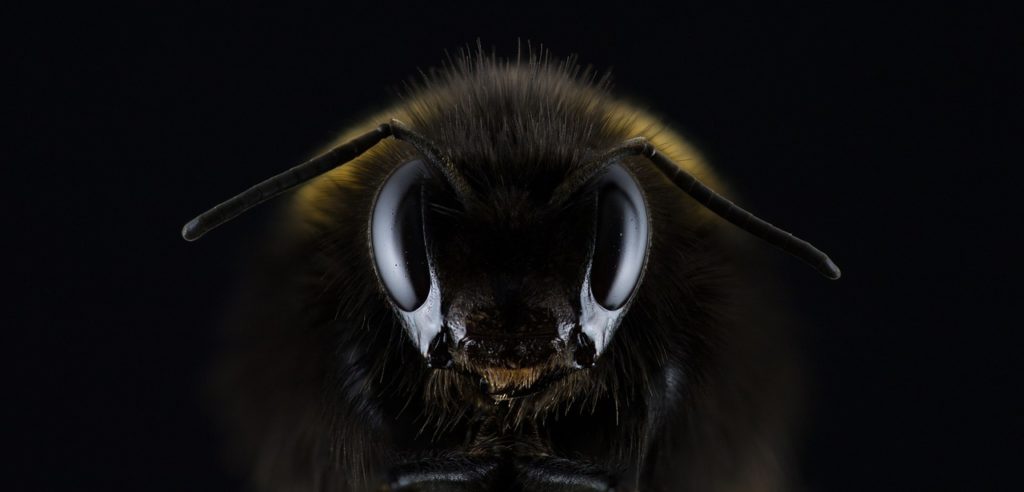
In the world of bees, the sky is usually the limit. Apicultural technology, or #Apitech for the social media sphere, is hailed as the big hope to save the globally all-important bee with AI, IoT and Co. Yet some technological developments raise deep concerns of economic and ethic implications – and challenge us to think about what kind of agricultural utopia or dystopia we envisage for our future.
Humans have been exploiting honeybees for almost 9,000 years, say archaeologists. Practices surrounding apiculture, the cultivation of beehives, has changed remarkably little since over the centuries. Only when the large-scale collapse of bee colonies brought their salient importance to human food systems and our planet’s ecosystem in the spotlight, this is starting to change. For example, in the UK, one-third of the bee population has disappeared over the past ten years, and many of the wild bee species are in danger of becoming extinct.
In the face of these threats, many are eying on the potential of technologies to improve bee populations. For example, Ireland-based ApisProtect uses sensors, Internet of Things (IoT) technology and machine learning to give beekeepers access to better information on what is going on in the hive. In the US, scientists from Harvard are mounting tiny QR-coded backpacks on bees and installing a robotic tracking system above their hives to understand how certain pesticides might understand their behaviour. Meanwhile, the World Bee Project and IT firm Oracle announced to create a global network of Artificial Intelligence (AI) “smart hives” to give scientists real-time data into the relationships between bees and their environments
Yet technology is also fueling what looks like the dystopian nightmares of environmental activists. The logic is simple: If the bees do not like the industrialized and monocultural fields that mean big business in Europe and overseas – then why not change the bees rather than the industry?
There are some indications that scientists are already experimenting with a new gene-editing technique called Crispr. It allows to cut and insert pieces of the DNA strands with great precision. Metaphorical speaking, Crispr is the magic scalpel to dissect and redesign the genetic program of target organisms. The end result could be a genetically modified bee – dubbed either ‘Superbee’ or ‘Frankenbee’, depending on what political position is taken.
Among its strongest opponents is the European Professional Beekeepers Association, who fears that genetically modified bees will bring in patents and privatization in “the one area that big Ag doesn’t yet control” – namely pollination”. Bees help to pollinate 70 of the 100 crop species that feed 90% of the world’s population, including apples, almonds, coffee, cocoa, peppers, tomatoes or potatoes. globally, between US$235 billion and US$577 billion worth of annual global food production relies on direct contributions by pollinators, estimates the UN Food and Agriculture Organization (FAO). Yet in Europe, the cultivation of these important pollinators is overwhelmingly private individuals – more than 90% of Europe’s beekeepers are non-professional.
There are more concerns: History may serve as a reminder that once genetic mutants have entered an ecosystem, it might prove impossible to remove them again in the face of unexpected harm they cause. In the 1950s, scientists in Brazil tried to cross two bee variants, the European mellifera, a rather sensitive creature known for its friendly character and excellent honey production, and the more resilient but less productive variant of mellifera bee that comes from Africa. However, while still in the experimental phase, a highly aggressive hybrid bee managed to escape. Its spread across the American continent in the following decades was marked by a dramatic surge in cases of sting-related deaths, earning them the name ‘Killer bees’ in public media.
Even more disconcerting, ‘killer bees’ might be the next weapon in 21st-century bio-tech warfare. European scientists have just voiced serious concerns about an US research program that explores how to use bees and other insects to transmit and spread engineered viruses. This viral cocktail would basically act as genetic modification agents, altering the plants’ DNA to be resilient against epidemic pests.
The project runs under the innocent name of Insect Allies, yet some suspect this alliance might be taken to a much more dramatic level. The secrecy surrounding the project combined with staggering $45 million pumped into the project by the Department of Defense has alarmed the scientific community to officially enquire if the goal is really agricultural progress, or if a a “new bioweapon system” is in the making. Apart from pacific-minded scientists, bee conservationist such as the European Professional Beekeepers Association, equally stated their determination to “keep an eye” on what they see as pure “craziness“.
“Technology is changing the game for conservation efforts”, believes John Abel, Project Director from Oracle Cloud who just introduced the ‘Smart Hive’ network powered by AI. “Using cloud-based technology, the World Bee Project is going to have a truly global, real-time view of bee population health for the first time. This will arm researchers with the information needed to work with governments and beekeepers to help reduce the decline in honey bee populations.”
However, technology is not a wonder weapon, but can be the means to very different ends – including turning bees into actual weapons or genetically adapting them to become another high-tech addition to today’s global agricultural system.




